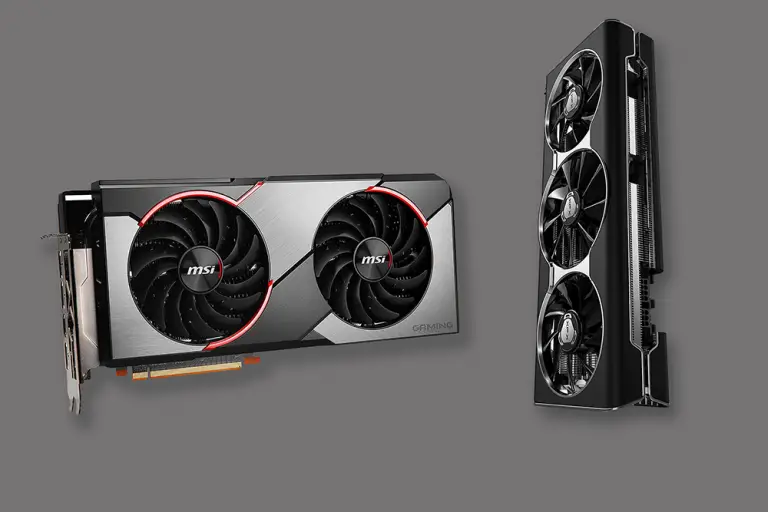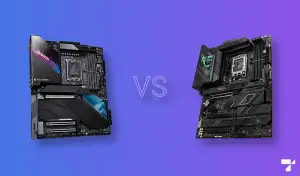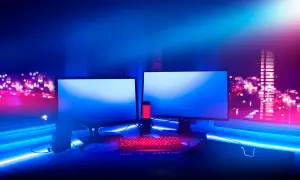When you’re looking to get a graphics card, Nvidia and AMD are the two companies you have to choose from. A lot of people consider AMD to provide better value, so below we have reviewed the best AMD graphics cards. We’ll be covering both the latest options, and some of the older ones that can still handle modern gaming rather easily.
And while many would just go for the newest model to guarantee future-proofing, there’s no denying that the drop in price for some of the older models means you can get a more powerful GPU for less money, which is why they’re on our list. Without wasting any more time, let’s take a look at the options.
1. AMD Radeon RX 5700 XT
The top of the line model from AMD’s latest lineup of GPUs is the RX 5700 XT. Even though it’s far from cheap, if this is the price range that works for you, you’ll be hard-pressed to find a better GPU than the RX 5700 XT.
The GPU comes with 8GB of GDDR6 memory, and the memory specs are pretty much identical to the slightly cheaper RX 5700 – 14Gbps effective speed, 256-bit interface, and a maximum bandwidth of 448 GB/s. However, when you start looking at frequencies and performance figures, things change a bit.
The RX 5700 XT comes with a base frequency of 1605 MHz, but when you’re gaming, it’s going to go up to 1755 MHz. That’s not all, however, since the maximum is a rather high 1905 MHz, which should give you quite a bit of boost in total. Then there are the 19.51 TFLOPs peak performance, which is excellent, and the fact that you’re looking at 2560 stream processors and 160 texture units.
Overall, there are a lot of reasons to go for the RX 5700 XT, which is a very powerful GPU that comes at a fraction of the price of competing models by Nvidia. It’s the best AMD graphics card for people looking at that price range.
2. AMD Radeon RX 5600 XT
Somewhere in the middle of AMD’s lineup of modern GPUs sits the RX 5600 XT. And for people looking for a reasonable midrange price and excellent performance during 1080p gaming, it’s a great purchase, for a lot of reasons.
Built on AMD’s RDNA architecture, it comes with all the software benefits like Radeon Image Sharpening, FidelityFX, and Integer Display Scaling. There’s 6GB of GDDR6 memory, with an effective memory speed of up to 14Gbps. Combined with a 192-bit interface, it gives you a maximum bandwidth of 336 GB/s.
When it comes to the GPU chip itself, you’re looking at a boost frequency of up to 1560 MHz. However, that’s only a maximum, since while gaming the GPU will probably sit at its game frequency, which is quite a bit lower at 1375 MHz. You’ll be getting a peak performance of 7.19 TFLOPs for half-precision computing, which is decent for the price.
Last but not least, at only 150W, this GPU is great for systems that don’t have a massive GPU – a 550W should suffice, but that does depend on your build. If you’ll be gaming at 1080p, it’s a great option.
3. AMD Radeon RX 5700
If you’re going for the best bang-for-the-buck GPU by AMD, the RX 5700, non-XT, is the model you should be going after. It’s designed for 1440p gaming and comes with excellent specs for the price.
To begin with, you’re looking at 8GB of GDDR6 memory, with an effective memory speed of 14Gbps. When you add to this the maximum memory bandwidth of 448 GB/s, you’ve got yourself a great GPU that can handle quite a lot in terms of modern games.
The 5700 comes with a base frequency of 1465 MHz, but if necessary, it can boost up to 1725 MHz. There’s also the 15.9 TFLOPs half-precision compute peak performance, as well as 2304 stream processors and 144 texture units that make this a rather powerful GPU.
When you combine all of this with the price, you’re looking at a GPU that won’t break the bank, yet will let you play games at 1440p with rather decent settings, and push things all the way at 1080p gaming.
4. AMD Radeon VII
Before we had the RX 5xxx models, which are based on a 7nm process, we got the AMD Radeon VII. It was the first 7nm GPU, but due to its rather high price, it didn’t live all that long. Today, since you can get it for more reasonable prices than its launch price, it’s an interesting option for gamers.
The Radeon VII that launched in 2019 still used HBM2 memory, but it came with 16GB of it. HBM2 memory does have low effective speed, 4 Gbps in this case, but the memory interface being 4096-bit means that you’re looking at a maximum memory bandwidth of 1024 GB/s. To say this is impressive would still be underestimating.
The GPU itself has a base frequency of 1400 MHz but can boost up to 1750 MHz, with a peak at 1800 MHz. The peak half precision compute performance is a pretty high 27.7 TFLOPs, and you’re getting 3840 stream processors in total.
The Radeon VII is also very power-hungry GPU. It needs around 300W, which translates into a 750W power supply at least. But if you don’t mind this, and want to have the first 7nm GPU, by all means, go for it.
5. AMD Radeon RX 5500 XT
Users on a budget who don’t want to buy used, take note – the RX 5500 XT is a great choice for you, especially for 1080p gaming. It’s priced really aggressively, and it has an excellent performance in most games.
Even though a budget GPU, it comes with 8GB of GDDR6 memory. The maximum bandwidth is 224GB/s, which is rather decent. There is a pretty modest number of stream processors at 1408, but at this price, you can’t really complain, can you?
What’s particularly impressive about the RX 5500 XT is that it only consumes around 130W of power at its peak. For a budget build, this means that you could potentially get away with something like a 450W PSU, but if you want to stay on the safe side, go for at least a 500W model. You will need an 8-pin power connector to run it, though.
The RX 5500 XT supports things like 4K h264 encoding and decoding, as well as h265/HEVC encoding and decoding, and comes with a DisplayPort 1.4 port and an HDMI port that supports up to 4K60 output. Overall, it’s a great budget GPU for users who don’t feel the need to play at the highest settings.
6. AMD Radeon RX 590
At one point, the RX 590 was AMD’s flagship mainstream GPU. It launched back in 2018, and it was the best RX 5xx model you could get, with a price to boot. Today, there are better models, which means you can get the RX 590 at a great price, and you’ll have a really good GPU for 1080p gaming.
To begin with, the RX 590 came with 8GB of GDDR5 memory. That memory had an effective speed of 8 Gbps, and with a 256-bit interface, you were looking at a maximum bandwidth of 256 GB/s. This is pretty sufficient for most modern titles if you play them at 1080p, but you might get in trouble if you try to go to 1440p, for example.
The GPU chip itself has a base frequency of 1469 MHz, but it can boost up to 1545 MHz. There’s a total of 2304 stream processors and 144 texture units as well. And while AMD themselves don’t have a recommended power figure, you’ll want at least a 650W PSU to run the RX 590 without issues.
7. AMD Radeon RX Vega 64
People who play at high resolutions, such as 1440p, or sometimes even 4K, demand a lot of power, and AMD’s answer is the RX Vega 64. Even though at this point, it’s almost a 3-year-old GPU, you’re looking at a graphics card that can still handle demanding games better than most of today’s models.
First things first, it uses very high-performance HBM2 memory. With an effective speed of “only” 1.89Gbps, you’re getting a bandwidth of 483.3GB/s, which is slightly better than the RX 5700 XT which is the current mainstream flagship.
And it’s not just the memory, the GPU chip itself is extremely powerful, too. The frequencies might not seem like too much – the base is 1247 MHz, and the boost is 1546 MHz. However, there’s a peak performance of 25.3 TFLOPs, which is better than anything else AMD offers currently.
However, not only is it expensive, but it is also very demanding – it consumes around 300W of power, and you’ll want at least a 750W PSU to run it well. If that’s not a problem, it’s a great choice for gaming.
8. AMD Radeon Vega 56
Sitting right below the Vega 64 graphics card is the Vega 56. It’s a slightly older model than the RX 5xxx models we’ve got today and is built on the Vega architecture instead of AMD’s RDNA. And this is exactly why you can get it today at a pretty reasonable price for a GPU this powerful.
The Vega 56 makes use of HBM2 memory, and you’ve got 8GB of it. Even though the effective memory speed is 1.6 Gbps, the 2048-bit memory interface allows it to get a maximum memory bandwidth of 410GB/s, which is slightly less than an RX 5700.
The GPU itself is pretty good, you’re looking at a base frequency of 1156 MHz, and a maximum boost frequency of up to 1471 MHz. The peak half precision compute performance sits at 21 TFLOPs, which is pretty decent, and the Vega 56 has an impressive 3584 stream processors and 256 texture units.
However, this also has the Vega architecture’s downfall, and that’s the heat and massive power consumption. The GPU can go up to 210W, and you’ll want at least a 650W PSU to run it comfortably. If this isn’t an issue, though, it’s a pretty great GPU.
9. AMD Radeon RX 580
Even though the RX 580 used to command a rather high price, especially during the Bitcoin madness when everyone bought them for their mining performance, today you can get it for a decent price and enjoy the high performance. And we aren’t just referring to 1080p, as this is a rather capable GPU that can be pushed at 1440p as well.
The RX 580 has 8GB of GDDR5 memory since it’s a GPU that came out in 2017 when GDDR6 memory wasn’t really a thing. It still has 8 Gbps effective memory speed and a maximum bandwidth of 256 Gb/s, which isn’t all that bad. To add to this, you have 2304 stream processors and 144 texture units, which is rather reasonable.
What’s interesting is that even though this is a GPU from the time when people steered clear of AMD due to their high temperatures and power consumption, the RX 580 consumes a moderate 185W of power. You could run it at 500W, but we’d suggest at least a 600W PSU.
Overall, if you don’t mind an older GPU and would like to save a few bucks instead (maybe for a more powerful PSU?) the RX 580 is excellent value.
10. AMD Radeon RX 570
People who won’t be gaming at anything more than 1080p could very well save quite a few bucks by going with an older GPU – and the RX 570 by AMD is an excellent value if that’s what you’re after. You can push competitive titles to very high framerates, and even some AAA titles will be playable if you don’t expect too much.
The specs are pretty much what you’d expect from a mid-range GPU released in 2017 – 8GB of GDDR5 memory with a total bandwidth of 224 GB/s, 2048 stream processors, and 128 texture units. This might not be anything to write home about, but for 1080p gaming, it’s actually quite enough. The base frequency is 1168 MHz, while the boost frequency is up to 1244 MHz.
What’s interesting is the power consumption – it only uses 150W, which means that a 450W or 500W PSU is actually sufficient for your build. There’s DisplayPort 1.4, as well as HDMI with 4K60 support, but there are no Dual-Link DVI or VGA ports. If this is something you’re okay with, by all means, go for it.
The GPUs above are the best options AMD has to offer. You can select which one is suitable for your PC Build based on the performance you desire and your budget. Additionally, you can learn more about AMD graphics cards here. You can also check out Tom’s Hardware GPU Hierarchy to see the full list of GPUs available.



